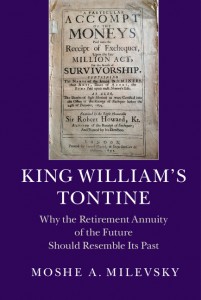 Here’s my latest MoneySense blog, entitled Tontine: Retirement Plan of the Future, which describes a new book by retirement guru Moshe Milevsky entitled King William’s Tontine. We will follow with a guest blog by Moshe himself on Thursday elaborating on his vision of tontine-like structures as a 21st century fix for declining Defined Benefit plan coverage and rising longevity expectations. In some respects, the Tontine — all but banished in many countries — resembles life annuities. Movie goers may recall a movie where the tontine prominently features: The Wrong Box.
Here’s my latest MoneySense blog, entitled Tontine: Retirement Plan of the Future, which describes a new book by retirement guru Moshe Milevsky entitled King William’s Tontine. We will follow with a guest blog by Moshe himself on Thursday elaborating on his vision of tontine-like structures as a 21st century fix for declining Defined Benefit plan coverage and rising longevity expectations. In some respects, the Tontine — all but banished in many countries — resembles life annuities. Movie goers may recall a movie where the tontine prominently features: The Wrong Box.
Given this week’s press coverage of the voluntary expansion of the Canada Pension Plan (CPP), Milevsky’s book is all the more timely, since it ’s all about longevity insurance and true pensions: that is, life annuities and true Defined Benefit pensions. (NOT Defined Contribution plans, RRSPs, TFSAs, etc., which are really capital accumulation plans that have no implicit guarantee of an income for life, no matter how long you live to.).
For one-stop shopping and archival purposes, we also run the blog below:
By Jonathan Chevreau
Advances in life expectancy coupled with the decline of employer-sponsored Defined Benefit pension plans has greatly raised anxiety levels about seniors outliving their money.

Life annuities have long been touted as one possible remedy for prolonged longevity, which is why experts like finance professor Moshe Milevsky have dubbed them a form of “longevity insurance.”
But a more effective “retirement annuity” could be an almost-forgotten structure that originated in Europe in the 17th century. It’s called the tontine, a relatively unknown concept in modern times, although it has from time to time featured in various Hollywood movies (notably the novel and movie The Wrong Box).
A tontine is a seemingly morbid concept that involves the pooling of investments such that those who die end up subsidizing those who keep living. And Milevsky believes it’s time the financial industry or even Governments stepped in to breathe new life into the concept.
The idea is presented in a just-published Cambridge University Press book entitled King William’s Tontine: Why the Retirement Annuity of the Future Should Resemble its Past.
William Shakespeare may have been a tontine beneficiary
Milevsky goes back to the first tontine issued by the English government in 1693, when King William created a tontine designed to finance his war against France. It’s a fascinating look at European history through a financial lens, particularly as he makes the case for one William Shakespeare being the beneficiary of an early Tontine, something that perhaps furnished enough leisure for the Bard to pen his much loved plays.
The history is one thing but Moshe looks to the future in his final chapter, where he concludes “I believe tontines and annuities should be a (bigger) part of the retirement income cocktail.”
Milevsky has also just published the second edition of his best-selling Pensionize Your Nest Egg, which takes a more conventional approach to the same problem of longevity and creating guaranteed incomes for life.
Time for financial industry to embrace “tontine thinking”
In King William’s Tontine, he challenges the financial industry to start engaging in what he terms “tontine thinking” as a way out of the huge longevity risk pensions and insurance companies are bearing. A conventional life annuity exposes insurance companies to longevity risk from day one but with a tontine scheme, “the risk is shared by the pool itself. The company guarantees nothing. They are merely custodians and managers.”
Milevsky mentions the problems of three major insurance companies in 2008: Canada’s Manulife Financial, AIG and Equitable in the UK (a decade earlier). In particular, he cites the near disastrous episode Manulife suffered with a variable annuity called Guaranteed Living Withdrawal Benefits, or GLWBs, and which he says almost brought the company and the possibly the whole industry to the point of insolvency.
The problem was its attempt to guaranteed a lifetime of income via the stock market. “The stock market isn’t a place for guarantees.” These turned out to be mispriced greatly in favor of consumers, and to the disadvantage of the issuers.
He quotes one expert who declared “Insurance companies and pension funds guaranteed too much. They should promise only what they can keep.” Or as Milevsky puts it, they should stick to the business of sharing, pooling and transferring risk only. That’s what tontine thinking is all about: spreading risk across a group, sharing it within the group and absorbing it within a group.
Two worlds: Investment Tribe vs insurance Clan
Milevsky divides the financial world into the “investment tribe” and the “insurance clan,” arguing both groups could benefit from tontine thinking. The investment tribe puts its faith in stocks and bonds and William Bengen’s 4% Rule, while the insurance tribe is infatuated with the benefits of life annuities.
His conclusion is that tontine annuities should be added to the “approved and endorsed” menu of financial and insurance products available to de-accumulate wealth at retirement.: in addition to stocks, bonds, cash, real estate, long-term care policies and even conventional annuities, so long as the insurance companies don’t charge too much for the guaranteed.
His own “blunt” closing sentences include this intriguing passage: “…the only way for individuals in society to afford the retirement they dream of is for them to embrace the idea that the dead (retirees) should subsidize the living (retirees.). Longevity risk should be shared. I encourage baby boomers and their children to enter into a longevity-sharing pact with others in their cohort so that the assets and wealth of the deceased can be used to enhance the returns of the living. You can extend the longevity of your money and your portfolio if you embrace tontine thinking.”

